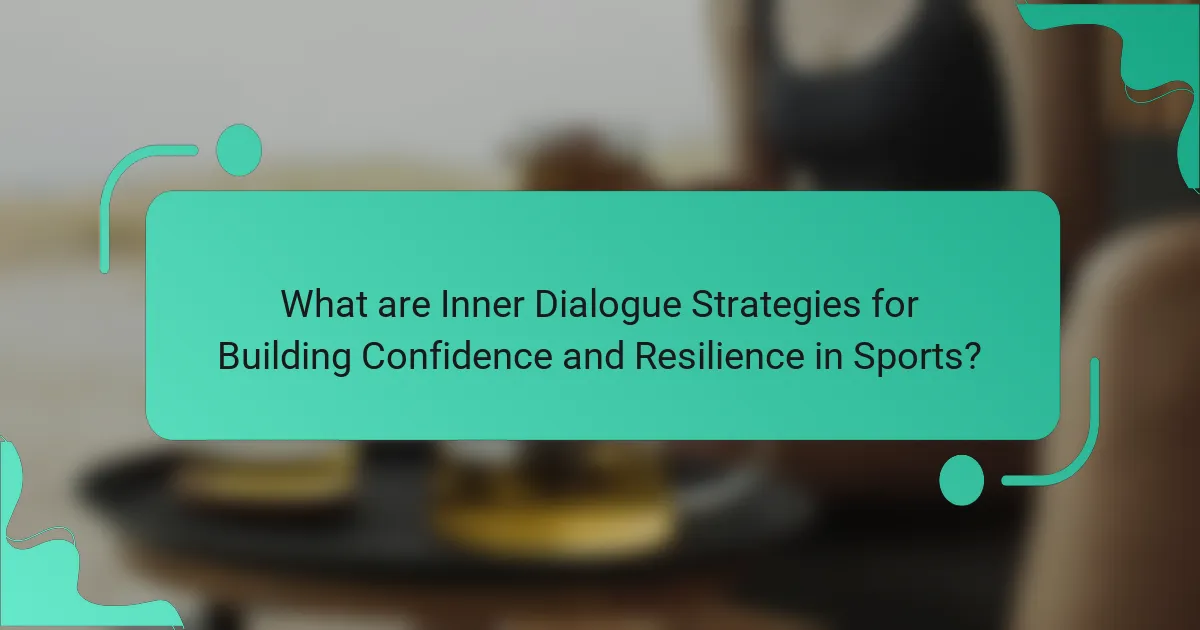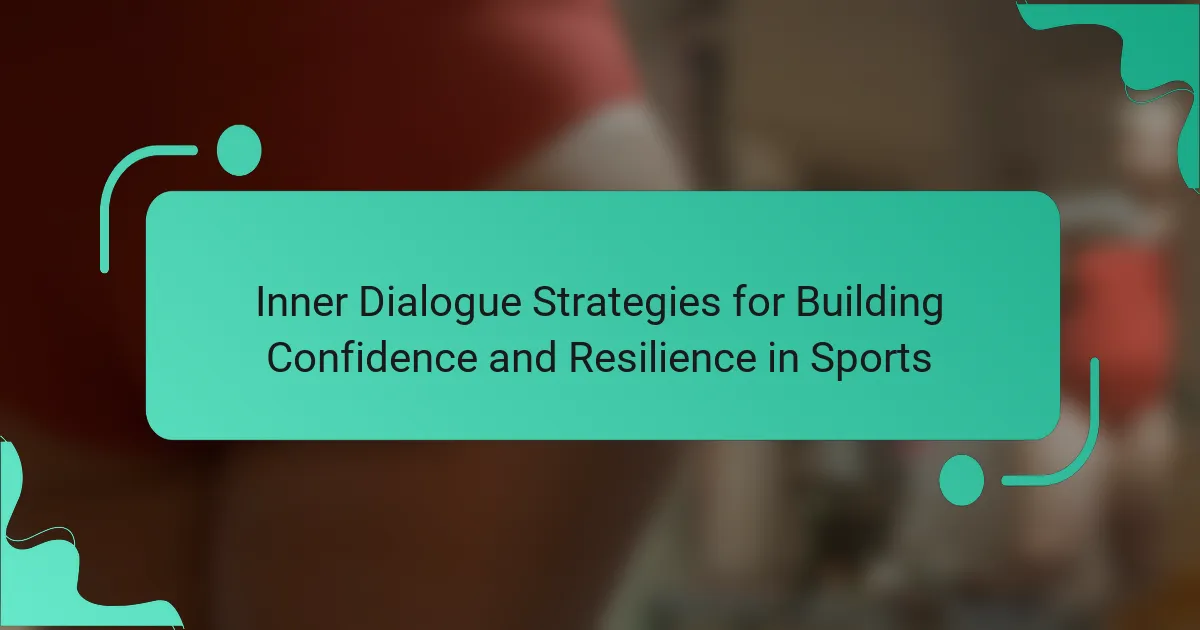Building confidence and resilience is crucial for athletes facing competitive challenges. Inner dialogue strategies, such as positive affirmations and visualization, enhance self-belief and focus. Techniques like reframing negative thoughts provide opportunities for growth. Understanding cultural influences on self-talk can further tailor these strategies for improved performance.

What are Inner Dialogue Strategies for Building Confidence and Resilience in Sports?
Inner dialogue strategies enhance confidence and resilience in sports by fostering a positive mental environment. Techniques include positive affirmations, visualization, and reframing negative thoughts. Positive affirmations build self-belief, while visualization prepares athletes mentally for performance. Reframing helps athletes view challenges as opportunities for growth. These strategies cultivate a strong mental framework, essential for overcoming obstacles and achieving peak performance.
How does inner dialogue influence athletic performance?
Inner dialogue significantly enhances athletic performance by fostering confidence and resilience. Positive self-talk can improve focus, reduce anxiety, and increase motivation. Athletes using affirmations and visualization techniques often experience enhanced mental clarity and determination. Research indicates that consistent inner dialogue strategies lead to improved performance metrics and overall psychological well-being in sports.
What are the key components of effective inner dialogue?
Effective inner dialogue involves self-awareness, positive affirmations, and constructive feedback. These components help athletes build confidence and resilience. Self-awareness allows individuals to recognize negative thoughts. Positive affirmations reinforce strengths and capabilities. Constructive feedback focuses on improvement rather than criticism, fostering a growth mindset. Together, these elements create a supportive inner voice that enhances performance and mental toughness in sports.

What universal attributes contribute to building confidence through inner dialogue?
Positive inner dialogue builds confidence by fostering self-acceptance and resilience. Key attributes include self-affirmation, constructive feedback, and visualization techniques. These strategies empower athletes to overcome challenges and enhance performance. Emphasizing positive self-talk can reduce anxiety and improve focus, leading to greater success in sports.
How can positive affirmations enhance self-belief?
Positive affirmations significantly enhance self-belief by reshaping inner dialogue. They create a positive mental environment, which fosters confidence and resilience in sports. Regularly practicing affirmations helps athletes reframe negative thoughts, replacing them with empowering beliefs. This mental shift can lead to improved performance, as athletes become more assured in their abilities. As a result, the consistent use of positive affirmations can cultivate a strong sense of self-worth, essential for overcoming challenges in competitive settings.
What role does visualization play in sports confidence?
Visualization significantly enhances sports confidence by enabling athletes to mentally rehearse successful performances. This mental imagery fosters a positive inner dialogue, reinforcing belief in one’s abilities. Athletes who effectively visualize their actions often experience reduced anxiety and improved focus during competition. Research indicates that visualization can lead to measurable improvements in performance, as it activates similar brain regions as actual practice. By integrating visualization into their training, athletes build resilience, allowing them to overcome challenges and setbacks more effectively.
How can reframing negative thoughts improve resilience?
Reframing negative thoughts enhances resilience by shifting focus to positive outcomes. This strategy promotes a growth mindset, allowing athletes to view challenges as opportunities. By recognizing and altering detrimental thought patterns, individuals can improve performance and maintain motivation. Research shows that cognitive restructuring significantly boosts mental toughness, fostering a stronger response to adversity.

What unique strategies can athletes employ for effective inner dialogue?
Athletes can employ visualization, affirmations, and mindfulness to enhance their inner dialogue. Visualization involves imagining successful performances, boosting confidence and focus. Affirmations, or positive self-statements, reinforce self-belief and resilience. Mindfulness practices help athletes stay present, reducing anxiety and fostering a positive mindset. These strategies cultivate a supportive inner voice, essential for peak performance.
How can athletes tailor their inner dialogue to their specific sport?
Athletes can tailor their inner dialogue by focusing on sport-specific affirmations and visualization techniques. These strategies enhance confidence and resilience tailored to their unique challenges.
For example, a sprinter might use phrases like “I am fast and focused” during training, while a team player could emphasize “I contribute to our success.” Visualization of successful performances can further reinforce these messages.
Additionally, athletes should regularly assess their self-talk, replacing negative thoughts with constructive ones. This practice fosters a positive mindset essential for overcoming obstacles in their sport.
Ultimately, customizing inner dialogue to align with specific sport demands can significantly improve an athlete’s mental strength and performance.
What techniques can be used to create personalized affirmations?
Personalized affirmations can be created using techniques like identifying core beliefs, focusing on strengths, and incorporating specific goals. Start by reflecting on personal experiences to uncover limiting beliefs. Then, articulate affirmations that highlight strengths and achievements, ensuring they are specific and actionable. For example, rather than saying “I am confident,” say “I perform well under pressure.” Additionally, regularly revisiting and adjusting affirmations can maintain relevance and effectiveness, fostering a stronger inner dialogue.

What are some rare but impactful inner dialogue techniques?
Some rare but impactful inner dialogue techniques include visualization, reframing negative thoughts, and using affirmations tailored to specific situations. These strategies enhance mental resilience and foster confidence in athletes.
Visualization involves creating vivid mental images of success, which can improve performance. Reframing negative thoughts helps athletes shift their mindset, turning self-doubt into motivation. Tailored affirmations, specific to individual goals, reinforce positive self-talk and build a strong mental foundation.
How can athletes use storytelling to boost confidence?
Athletes can use storytelling to enhance confidence by creating a narrative that reinforces their strengths and experiences. This technique allows athletes to visualize success, transforming past challenges into motivational stories. By focusing on personal victories and learning moments, they cultivate resilience and a positive inner dialogue that boosts performance.
What uncommon visualization methods can enhance performance?
Uncommon visualization methods like guided imagery, mental rehearsal, and color visualization can enhance performance in sports. These techniques allow athletes to mentally simulate scenarios, fostering confidence and resilience. Guided imagery involves creating detailed mental pictures of successful performances. Mental rehearsal focuses on practicing skills in the mind to improve execution. Color visualization uses specific colors to evoke emotions and enhance focus. These strategies can lead to improved mental clarity and better performance outcomes.

How does cultural background influence inner dialogue in sports?
Cultural background significantly shapes inner dialogue in sports by influencing athletes’ beliefs and self-talk patterns. Different cultures emphasize distinct values, such as collectivism or individualism, which can affect how athletes perceive their abilities and challenges. For instance, athletes from collectivist cultures may focus more on team success, leading to supportive inner dialogues that enhance resilience. Conversely, those from individualistic backgrounds might adopt a more self-reliant perspective, fostering confidence through personal achievements. Recognizing these cultural influences allows athletes to tailor their inner dialogue strategies, enhancing their performance and mental fortitude.
What regional variations exist in the perception of self-talk?
Perceptions of self-talk vary significantly across regions, influenced by cultural attitudes towards mental health and sports. In collectivist cultures, self-talk often emphasizes team cohesion and communal support, while individualistic cultures may focus on personal empowerment and self-affirmation. Research indicates that athletes in Eastern cultures may prioritize humility and restraint in their inner dialogue, contrasting with Western athletes who might adopt more assertive and motivational self-talk strategies. Understanding these regional variations can enhance coaching methods and athlete performance globally.
How can athletes from different backgrounds adapt their strategies?
Athletes from different backgrounds can adapt their strategies by leveraging inner dialogue techniques to enhance confidence and resilience. Tailoring self-talk to individual experiences fosters a supportive mental environment.
Athletes can practice positive affirmations, visualize success, and reframe negative thoughts. These methods help in overcoming challenges unique to their backgrounds. Research indicates that athletes who utilize constructive inner dialogue demonstrate improved performance and mental toughness.
Additionally, collaboration with coaches and peers from diverse backgrounds can provide new perspectives. Sharing experiences and strategies promotes adaptive learning, enabling athletes to refine their approaches effectively.

What are the common mistakes athletes make with their inner dialogue?
Athletes often undermine their performance through negative inner dialogue. Common mistakes include self-doubt, catastrophic thinking, and comparison to others. These patterns can erode confidence and hinder resilience. Recognizing and reframing these thoughts is crucial for enhancing mental strength in sports.
How can negative self-talk sabotage performance?
Negative self-talk can significantly undermine performance by creating mental barriers and reducing confidence. It fosters a negative mindset, leading to anxiety and distraction during competition. Athletes may doubt their abilities, which can hinder focus and decision-making. Research indicates that positive inner dialogue enhances resilience, enabling athletes to overcome challenges and maintain peak performance.
What are the pitfalls of overthinking in competitive scenarios?
Overthinking in competitive scenarios can lead to decreased performance and heightened anxiety. It often results in self-doubt, which undermines confidence. Athletes may fixate on mistakes instead of focusing on the present moment. This distraction can diminish resilience, making it harder to adapt to challenges. Additionally, overthinking can obscure decision-making, leading to missed opportunities during critical moments in competition.

What best practices can athletes adopt for effective inner dialogue?
Athletes can enhance their inner dialogue by adopting positive affirmations, visualization techniques, and mindfulness practices. These strategies foster confidence and resilience during competition.
Positive affirmations involve repeating encouraging phrases that reinforce self-belief. Visualization techniques allow athletes to mentally rehearse successful performances, enhancing focus and reducing anxiety. Mindfulness practices, such as meditation, help athletes stay present, improving emotional regulation and decision-making under pressure.
By integrating these strategies, athletes can cultivate a supportive inner dialogue that empowers them to overcome challenges and achieve their goals.
How can journaling enhance self-reflection and dialogue?
Journaling enhances self-reflection and dialogue by providing a structured space for athletes to articulate thoughts and feelings. This practice fosters personal insights that build confidence and resilience in sports. Writing down experiences helps clarify emotions, identify patterns, and set goals. As a result, athletes can develop a deeper understanding of their mental states, leading to improved performance and emotional regulation. Regular journaling can also reveal unique attributes of personal growth, such as overcoming challenges and building a positive mindset.
What are expert tips for maintaining a positive mindset in sports?
To maintain a positive mindset in sports, focus on inner dialogue strategies that enhance confidence and resilience. Practice positive self-talk to counter negative thoughts and visualize successful outcomes. Set achievable goals to create a sense of accomplishment and reinforce your belief in your abilities. Regularly reflect on past successes to build a strong mental foundation and remind yourself of your progress. Engage in mindfulness techniques to stay present and reduce anxiety during competitions.
